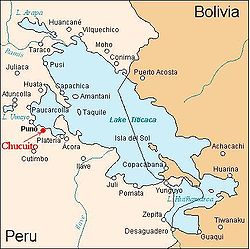Lupaca kingdom | |||||||||
|---|---|---|---|---|---|---|---|---|---|
| c. 1150–c. 1600 | |||||||||
 | |||||||||
| Capital | Cutimbo (1150-1463), Chucuito (1463-1600) | ||||||||
| Common languages | Aymara | ||||||||
| Government | Diarchy | ||||||||
| Historical era | Late Intermediate | ||||||||
• Established | c. 1150 | ||||||||
• Conquered by the Inca Empire under Pachacuti | c. 1463 | ||||||||
• Revolt crushed by Topa Inca Yupanqui | c. 1473 | ||||||||
• Disestablished | c. 1600 | ||||||||
| |||||||||
The Lupaca, Lupaka, or Lupaqa people were one of the divisions of the ancestral Aymaras. The Lupaca lived for many centuries near Lake Titicaca in Peru and their lands possibly extended into Bolivia. The Lupacas and other Aymara peoples formed powerful kingdoms after the collapse of the Tiwanaku Empire in the 11th century. In the mid 15th century they were conquered by the Inca Empire and in the 1530s came under the control of the Spanish Empire.
The residence of the pre-Inca kings of Lupaca was probably what is today the archaeological site of Cutimbo. The capital of the Inca province was Chucuito, presently a village of the same name where the archaeological site of Inca Uyu is located.


- ^ Hyslop, John (1977), "Chulpas of the Lupaca zone of the Peruvian High Plateau", Journal of Field Archaeology, Vol 4, No. 2, p. 150. Downloaded from JSTOR.